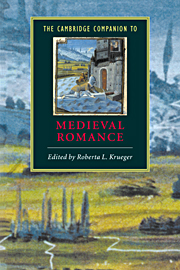Book contents
- Frontmatter
- Introduction
- Part 1 The origins, forms, and contexts of medieval romance
- Part 2 European romance and medieval society
- Part 3 European transformations
- 10 The evolution and legacy of French prose romance
- 11 Medieval German romance
- 12 Chivalry and medieval Italian romance
- 13 Gawain and popular chivalric romance in Britain
- 14 Middle English romance
- 15 Romance at the crossroads
- Editions and translations
- Index
- Series list
12 - Chivalry and medieval Italian romance
from Part 3 - European transformations
Published online by Cambridge University Press: 28 May 2006
- Frontmatter
- Introduction
- Part 1 The origins, forms, and contexts of medieval romance
- Part 2 European romance and medieval society
- Part 3 European transformations
- 10 The evolution and legacy of French prose romance
- 11 Medieval German romance
- 12 Chivalry and medieval Italian romance
- 13 Gawain and popular chivalric romance in Britain
- 14 Middle English romance
- 15 Romance at the crossroads
- Editions and translations
- Index
- Series list
Summary
Medieval vernacular romance is assumed to bear the stamp of the class to which it was first directed, namely the French feudal aristocracy of the twelfth century. Typically, in fact, the romances of other times, places, and socio-political contexts are compared to the first generation of French romance, and judged inadequate. The Old Italian romanzi rarely win praise from romance scholars, who tend to assume that their authors and audiences did not really understand what chivalry and chivalric literature originally meant. This assumption deserves scrutiny in light of the unusual, even unique, example of the Italian peninsula in the Middle Ages.
The Italian peninsula featured a variety of political systems quite unusual for medieval Europe. The south, including Sicily, was dominated by a monarchical model; after the death of Frederick II in 1250, though, the southern kingdom split into two hostile kingdoms, Angevin in Naples and Aragonese in Sicily. In the center and north, on the other hand, there was a myriad of smaller political organizations: semi-independent city-states called communes; the republic of Venice; the Papal State, including the territory around and north of Rome; the towns and lands governed by one noble family; and other intermediate forms of government. This political heterogeneity was not peaceful.
- Type
- Chapter
- Information
- The Cambridge Companion to Medieval Romance , pp. 203 - 217Publisher: Cambridge University PressPrint publication year: 2000

